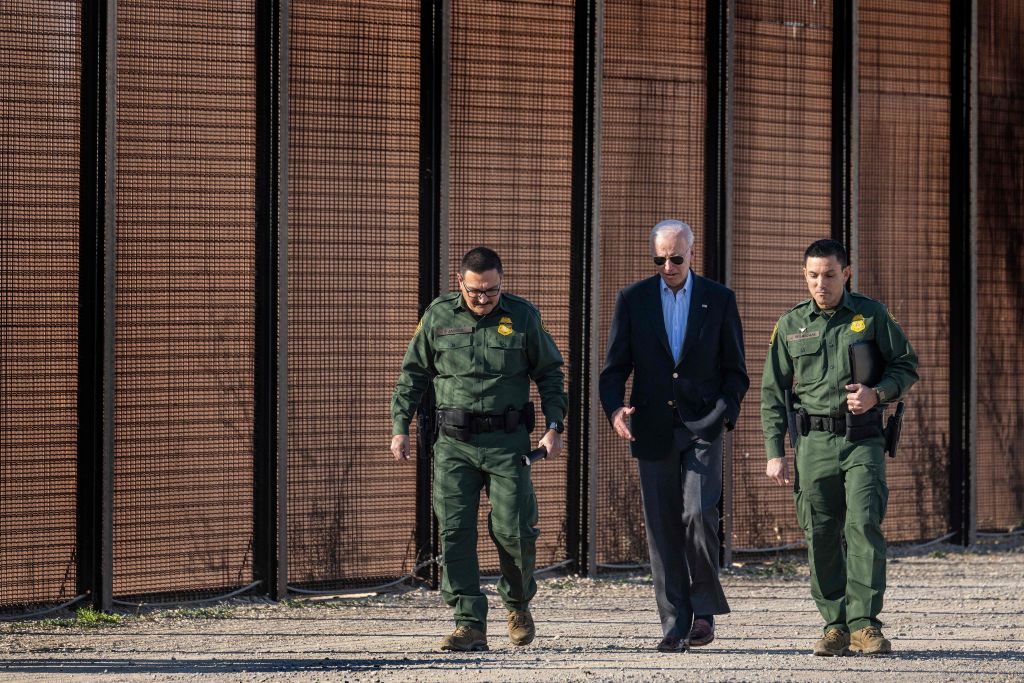The Biden administration on Thursday moved closer to adopting another Trump-era policy to deter asylum cases at the U.S.-Mexico border, despite President Joe Biden criticizing former President Donald Trump about the same issue while on the campaign trail in 2020.
Critics say Biden’s proposal shares the same flaws that led to Trump’s iteration being overturned by federal courts.
Biden’s rule, published in the federal register Thursday, would presume individuals arriving at the U.S.-Mexico border are ineligible for asylum if they traveled through another country without seeking protection there first. It makes limited exceptions for children and for medical emergencies, life-threatening circumstances, or for “severe” forms of trafficking. The changes also include expedited screening and removal processes (which in some cases could be wrapped up less than 72 hours after they begin).
It’s unclear whether Mexico will agree to accept detainees turned away by U.S. officials or if the removal proceedings will instead involve costly flights back to deportees’ home countries. The proposal—which the Biden administration says it plans to use only for two years—must go through a 30-day notice and comment period before implementation.
But Biden may face roadblocks: The rule requires cooperation with Mexico and the countries migrants may travel through en route to the United States. “The safe-third-country idea is a red line for us,” Roberto Velasco, Mexico’s Foreign Ministry chief officer for North America, told the New York Times in January. “It would overwhelm the system.”
The rule would likely result in a surge of migrants stuck in Mexico or deported to their home countries, while the number of migrants paroled into the United States to await adjudication of their asylum claims will fall sharply, immigration watchers say.
The administration first previewed the proposal in January, saying it is necessary in light of the upcoming end of Title 42, a pandemic-era health regulation that allowed border authorities to send migrants back to Mexico without processing their asylum claims. Biden kept Title 42 in place despite previously criticizing Trump for implementing the rule. “They’re sitting in squalor on the other side of the river,” Biden said in 2020.
Title 42 is set to wind down on May 11, along with the declaration that makes COVID-19 a national emergency. Once that happens, the Department of Homeland Security (DHS) estimates that authorities could encounter as many as 13,000 migrants per day along the border. In contrast, during a 30-day period beginning December 24, 2022, such daily encounters numbered between 7,100 and 9,700.
Seeing such a sharp spike of border encounters once Title 42 ends “risks undermining the Departments’ continued ability to safely, effectively, and humanely enforce and administer U.S. immigration law,” the Biden administration said.
Current asylum law offers temporary protection for those who meet the definition of a refugee but have not yet been legally recognized. Under U.S. law, refugees are those who have fled their countries due to “persecution or a well-founded fear of persecution” because of race, religion, or membership to a particular social group. Being granted asylum doesn’t guarantee authorization to stay in the U.S. if circumstances change and someone no longer fits refugee criteria, but it does include authorization to work and travel and bars deportation back to the person’s country of origin.
Immigration advocates, who have called previous iterations of Biden’s rule “a transit ban,” along with some 77 of Biden’s Democratic allies in Congress, say it flies in the face of U.S. immigration law.
“Trump’s cruel playbook has now become Biden’s legacy,” Bilal Askaryar of the asylum advocacy group Welcome With Dignity told reporters on Wednesday.
The rule change hasn’t won praise from immigration hawks either. They say it does little to address an unsecured border.
The Border Patrol Union called the move “smoke and mirrors,” and said it would “not stop illegal border crossers from claiming asylum.”
The move “is not a serious attempt by the Biden administration to end massive asylum abuse,” the anti-immigration Federation for American Immigration Reform said. “It’s a serious, and transparent attempt to remove the bad, and worsening optics of the migration crisis they created, as the president campaigns for reelection.”
Cue the lawsuits.
“The proposed asylum ban suffers from the same flaws as the Trump administration’s invalidated asylums bans, so we will be back in court if the Biden administration [carries] through with it,” Lee Gelernt, a senior lawyer for the American Civil Liberties Union, said in a statement. Gelernt won court battles against similar rules enacted during the Trump administration.
In 2020, the 9th Circuit Court of Appeals ruled against Trump’s proposal because it skipped a required notice-and-comment period but also deemed it inconsistent with asylum law. Trump’s ban also violated a statute that said asylum applicants can’t be turned away unless they are “firmly resettled” in a safe third country, the court ruled.
Under current law, authorities can deny asylum to those who traversed through a “safe third country” to the United States without applying for asylum there. But guidelines stipulate “safe” countries are those where applicants don’t face persecution due to race, nationality, or religion, countries with whom the United States has a “bilateral or multilateral” agreement, and that offer a “full and fair” process for adjudicating asylum requests.
Canada is the only country in the western hemisphere the U.S. currently has such an agreement with.
The Biden administration has argued that its ban differs from Trump’s because it will also loosen some immigration restrictions: The administration plans to allow Haitians, Nicaraguans, and Cubans to request humanitarian parole while in their home countries, provided they have a contact in the United States willing to sponsor them, along with a passport. The administration already implemented a similar process for Venezuelans last year.
Humanitarian parole is a rarely used status that temporarily allows otherwise inadmissible migrants to come to the United States. It’s typically reserved for emergencies, humanitarian crises, or for a particular public benefit (such as allowing someone to testify in court). The U.S. has at times expanded its use in special circumstances: 130,000 Vietnamese migrants were granted parole in 1975 when the U.S. pulled out from the Vietnam War, and Biden granted it to some Afghans after the U.S. withdrawal in 2021. But humanitarian parole does not confer permanent status, nor does it typically provide access to the same public benefits those with refugee status receive, such as food stamps or cash assistance.
“I hesitate to call it a new rule, because we’ve seen it before,” Krish O’Mara Vignarajah, president of Lutheran Immigration and Refugee Service, said on a call with reporters. The expansion of humanitarian parole, she noted, would only be available for some Central American countries, excluding migrants from others. “This recycled Trump rule is a stick that’s going to be used on everyone, while the carrot is only available to a fortunate few.”









Please note that we at The Dispatch hold ourselves, our work, and our commenters to a higher standard than other places on the internet. We welcome comments that foster genuine debate or discussion—including comments critical of us or our work—but responses that include ad hominem attacks on fellow Dispatch members or are intended to stoke fear and anger may be moderated.